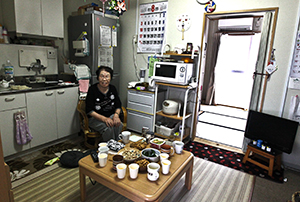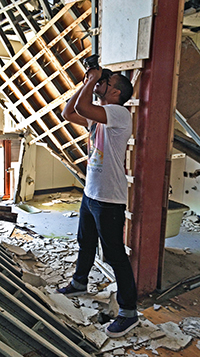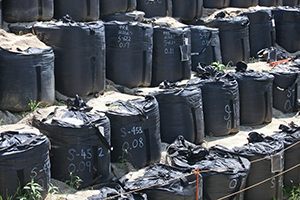Students document Fukushima survivors' stories
After spending two days interviewing an 83-year-old survivor of the 2011 Fukushima disaster, journalism student Deborah Svoboda found it difficult to say goodbye.
"I just felt I wanted to do more for her," said Svoboda. "She let me into her home. She gave me presents. That will probably stay with me forever."

Tomiyo Fujii, 83, sits in her home in the Sasaya Higashi temporary housing site in Fukushima City, Japan. Fujii's home, located in the town of Namie five kilometers from the Daiichi nuclear power plant, was washed away from the tsunami, and the entire town evacuated due to dangerous levels of radiation.
Svoboda was one of six SF State students and two faculty members who traveled this August to Fukushima, Japan, to report on the ongoing recovery from the tsunami and nuclear disaster that devastated the region nearly four years ago. The students have spent the fall semester completing their stories -- including those of survivors who are still struggling to piece their lives back together -- for a multimedia website scheduled to launch in the spring.
The goal of the project, said Professor of Journalism Jon Funabiki, one of the two faculty members involved, is to remind people outside of Japan that the story of the Fukushima disaster did not end when the news cameras left.
"One of the problems in journalism is we forget about these disasters after awhile and move on to the next disaster," he said. "This project was an attempt to respond to that problem."

Journalism student Gavin McIntyre photographs the inside of the destroyed gymnasium at Tomoya Junior High School, which was hit hard by the tsunami and has remained closed ever since.
The delegation was sponsored by SF State's Dilena Takeyama Center for the Study of Japan & Japanese Culture and received grant support from the Sasakawa Peace Foundation in Tokyo and training assistance from Voices of Witness. Fukushima University provided funding for lodging and program expenses. Five of the students are journalism majors, and the sixth is studying Japanese language and literature.
While in Japan, students spent two weeks fully immersing themselves in the story. They heard from government officials about radiation contamination and met with small business owners and tourism officials struggling to lure back customers. They toured an abandoned high school and learned how teachers and students had just 20 minutes to evacuate. They spent a day clearing vegetation on the property of an elderly man who has been unable to return to his home. And they spent two nights with local families, learning firsthand about how the tragedy affected them.
"My homestay family watched as the tsunami took away their house," Svoboda said. "Their grandmother made it to the top of the hill, but they couldn't get the grandfather out."
Assistant Professor of Journalism Sachi Cunningham, who also traveled with the delegation and who has extensive experience reporting on crises abroad, was impressed by the way students rose to the challenge of reporting on a sensitive story with limited time in a foreign country.
"They only had one free day, the last day of the two-week trip, and most of them continued to report," she said. "Most of them went back to the temporary housing areas and kept doing interviews, and I think that said a lot about how they were invested in the story and wanted to get as much out of it as possible."

Bags of contaminated soil line a plot of land at a temporary holding site in Fukushima, Japan. Students and faculty who traveled to Japan to report on the disaster recovery learned that the contaminated soil has been located there for more than a year, despite reassurances to residents that they would be gone in months.
In addition to gaining valuable field experience, the students involved also were able to put into practice a new brand of storytelling that Funabiki calls "restorative journalism." Instead of focusing on past crises, he said, restorative journalism encourages journalists to shed the objectivity and detachment they are accustomed to and tell stories focused on helping a community move forward.
"It's an antidote to the 'if it bleeds, it leads' approach to reporting," Funabiki said. And it's exactly the type of work Svoboda, who is graduating after this semester, hopes to continue doing.
"The whole reason I got into photojournalism is to try and tell stories I feel can help create change," she said. "There are still 70,000 people who can't go home. This is still going on, and we're hoping to keep the attention here a little longer."